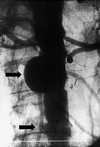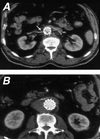Endovascular treatment of a noninfected anastomotic juxtarenal aortic aneurysm
- PMID: 11198318
- PMCID: PMC101114
Endovascular treatment of a noninfected anastomotic juxtarenal aortic aneurysm
Abstract
An 82-year-old man underwent an endovascular procedure with a commercially available endovascular graft for an anastomotic juxtarenal abdominal aortic aneurysm. The anastomotic aneurysm, which showed no sign of infection, developed 4 years after implantation of an aortic end-to-end graft for an infrarenal aortic aneurysm. The aneurysm was diagnosed during routine ultrasonographic follow-up; there was no apparent infection of the graft. Aortography confirmed the diagnosis and also revealed a small pseudoaneurysm at the level of the distal aortic anastomosis. Endovascular surgery was performed in the operating room with the guidance of C-arm fluoroscopy and intravascular ultrasound. Two Vanguard Straight Endovascular Aortic Graft Cuffs (26 x 50 mm and 24 x 50 mm) were implanted, successfully excluding both the anastomotic juxtarenal aortic aneurysm and the distal pseudoaneurysm. The renal arteries were preserved and no early or late endoleaks were observed. The patient was discharged 2 days after the procedure. Sixteen months later, he was alive and well, with no endovascular leakage, no enlargement of the aortic aneurysms, and no sign of infection. In our opinion, this experience shows that commercially available endovascular grafts may be used successfully to treat anastomotic aortic aneurysms and pseudoaneurysms.
Figures





Similar articles
-
Endovascular repair of paraanastomotic aneurysms after previous open aortic prosthetic reconstruction.Ann Vasc Surg. 2004 May;18(3):280-6. doi: 10.1007/s10016-004-0002-0. Ann Vasc Surg. 2004. PMID: 15354628
-
Endovascular repair of postoperative vascular graft related complications after aorto-iliac surgery.Int Angiol. 2014 Aug;33(4):386-91. Int Angiol. 2014. PMID: 25056171
-
Endovascular repair of an anastomotic leak following open repair of abdominal aortic aneurysm.Cardiovasc Intervent Radiol. 2007 Sep-Oct;30(5):1013-5. doi: 10.1007/s00270-007-9076-8. Epub 2007 May 29. Cardiovasc Intervent Radiol. 2007. PMID: 17533537
-
Endovascular treatment of aortic aneurysms of the abdominal aorta with covered stents.Cardiologia. 1999 Nov;44(11):949-56. Cardiologia. 1999. PMID: 10686769 Review.
-
Open repair for juxtarenal aortic aneurysms.J Cardiovasc Surg (Torino). 2013 Feb;54(1 Suppl 1):35-45. J Cardiovasc Surg (Torino). 2013. PMID: 23443588 Review.
Cited by
-
Resolution of an anastomotic aortic pseudoaneurysm 4 years after endovascular treatment.Tex Heart Inst J. 2004;31(3):330-2. Tex Heart Inst J. 2004. PMID: 15562863 Free PMC article. No abstract available.
-
Stent graft repair of anastomotic pseudoaneurysm of femoral-popliteal bypass graft following patch angioplasty.J Surg Case Rep. 2016 Dec 18;2016(12):rjw198. doi: 10.1093/jscr/rjw198. J Surg Case Rep. 2016. PMID: 27994009 Free PMC article.
-
Percutaneous Stent-Graft Repair of Anastomotic Pseudoaneurysms following Vascular Bypass Procedures: A Report of Two Cases.Case Rep Vasc Med. 2013;2013:124832. doi: 10.1155/2013/124832. Epub 2013 Jan 10. Case Rep Vasc Med. 2013. PMID: 23365781 Free PMC article.
References
-
- Szilagyi DE, Smith RF, Elliott JP, Hageman JH, Dall'Olmo CA. Anastomotic aneurysms after vascular reconstruction: problems of incidence, etiology, and treatment. Surgery 1975;78:800–16. - PubMed
-
- Mikati A, Marache P, Watel A, Warembourg H Jr, Roux JP, Noblet D, et al. End-to-side aortoprosthetic anastomoses: long-term computed tomography assessment. Ann Vasc Surg 1990;4:584–91. - PubMed
-
- Treiman GS, Weaver FA, Cossman DV, Foran RF, Cohen JL, Levin PM, et al. Anastomotic false aneurysms of the abdominal aorta and the iliac arteries. J Vasc Surg 1988;8:268–73. - PubMed
-
- Curl GR, Faggioli GL, Stella A, D'Addato M, Ricotta JJ. Aneurysmal change at or above the proximal anastomosis after infrarenal aortic grafting. J Vasc Surg 1992;16:855–60. - PubMed
Publication types
MeSH terms
LinkOut - more resources
Full Text Sources
